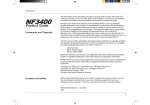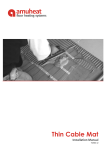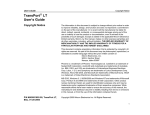Download micronPC CM900 User`s guide
Transcript
CM900 Monitor User’s Guide TABLE OF CONTENTS Monitor User’s Guide ......................................................... 3 Packing List ........................................................................ 3 Safety Information .............................................................. 3 Setup Instructions .............................................................. 5 Swivel Base ...........................................................................................5 Power Cord............................................................................................6 Video Cable ...........................................................................................7 Operating Instructions ....................................................... 8 General Instructions ..............................................................................8 Cleaning the Monitor..............................................................................8 Front Panel Controls..............................................................................8 Accessing the Adjustment Controls.....................................................10 Adjusting the Picture............................................................................11 Monitor Drivers ................................................................. 13 Warranty Information ....................................................... 13 Features ............................................................................ 13 Energy Star Standards ........................................................................13 Plug & Play DDC1/2B Feature.............................................................14 Appendix A — Troubleshooting ...................................... 14 Appendix B — Factory Preset Timing ............................ 16 Appendix C — Connector Pin Assignment .................... 17 Appendix D — Monitor Specifications............................ 17 Appendix E — FCC Notice ............................................... 19 2 MONITOR USER’S GUIDE This user’s guide provides important information about operating your monitor. Before using the monitor, please read the guide thoroughly, and then save it for future reference. PACKING LIST Before setting up and using your monitor, examine the items in the monitor package. If anything is missing or damaged, please contact MicronPC immediately. Look for the following items: • • • • 19-in Cathode-Ray Tube (CRT) Monitor CM900 Monitor User’s Guide 100/120 VAC rated Power Cord Swivel Base Note: Save the original shipping carton and packing materials in case you ever need to transport or ship your monitor. If you transport the monitor over long distances, completely repackage the monitor in its original packing material. SAFETY INFORMATION • Do not use the monitor near standing bodies of water or in humid envirionments. • Set the monitor on a flat, stable surface. Do not place it on an unstable cart, stand, or table. If the monitor falls, it might injure a person and/or cause serious damage to the monitor. • When placing the monitor on a cart or stand, use only a cart or stand recommended by the manufacturer or sold with the monitor. If you mount the monitor on a wall or shelf, use a mounting kit approved by the manufacturer and follow the kit instructions. • Slots and openings in the back and bottom of the monitor are provided for ventilation. To ensure reliable operation of the monitor, and to protect it from overheating, these openings must not be blocked or covered. Do not place the monitor on a bed, sofa, rug, or similar surface. This monitor must never be placed near or over a radiator or heat register. This monitor must not be placed in a built-in enclosure of any kind unless proper ventilation is provided. 3 • The monitor must only be connected to the AC power source as indicated on the label. If you are unsure of the type of AC power available, ask your local power company. Only connect this monitor to a power outlet that matches the power requirements of this monitor. • The monitor is equipped with a three-prong, grounded plug (a plug with a third pin for grounding). For safety purposes, this plug will only fit into a grounded power outlet. If your outlet does not accommodate the threewire plug, have an electrician install the correct type of outlet, or use an adapter to ground the appliance safely. • During a lightning storm, unplug the monitor. Also unplug the monitor when it will not be used for a long time. This will protect the monitor from damage due to power surges. • Do not overload power strips and extension cords. Overloading power strips and extension cords can result in a fire or electric shock. • Never push objects of any kind into the monitor through openings. The objects could touch dangerous voltage points or short out parts, possibly resulting in an electric shock or a fire hazard. • Never spill liquid of any kind on the monitor. If this occurs, disconnect the monitor from the power source immediately. • Do not attempt to service the monitor yourself. Opening or removing the monitor’s cover can expose you to dangerous voltages and other hazards. Please refer all servicing to qualified service personnel. • To ensure satisfactory operation, only use the monitor with UL listed computers that have the appropriate configured receptacles marked between 100–240 VAC, Min. 1.5A. • Do not allow anything to rest on the power cord. Do not place the monitor where people might walk on the cord. • Do not place the monitor in direct sunlight or where it is near excessive dust or mechanical vibration or shock. Warning: To prevent a fire or shock hazard, do not expose the monitor to rain or moisture. Dangerously high voltages are present inside the monitor. Do not open the monitor cabinet. Refer servicing to qualified personnel only. Warning: Keep all packing materials away from children. 4 SETUP INSTRUCTIONS This section provides information for attaching the swivel base to your monitor and for using the power cord and video cable. Swivel Base To attach the swivel base to the monitor, complete the following steps: 1 Carefully turn the monitor upside down. (See Figure 1.) 1 2 Figure 1: Installing and Removing the Swivel Base 2 3 Facing the monitor screen, locate the openings on bottom of the monitor. Insert the swivel base’s pegs into the openings. Pull the swivel base forward toward the front of the monitor until the swivel base locks in place. To remove the swivel base, complete the following steps: 1 Carefully turn the monitor upside down. (See Figure 1.) 2 Facing the monitor screen, grasp the bottom of the swivel base, press down on the locking mechanism and push it backward until the base is released. 5 Adjusting the Monitor’s Viewing Angle • For optimal viewing it is recommended to look at the full face of the monitor, then adjust the monitor’s angle to your own preference. • Hold the base so you do not topple the monitor when you change the monitor’s angle. • • You are able to adjust the monitor’s vertical angle from 5° to 15°. You are able to adjust the monitor’s horizontal angle from 90 to 90°. 15O 90O 90O 5O Centering Mark Figure 2: Adjusting the Monitor’s Viewing Angle To find the center of the monitor’s swivel radius, align the center of the creen with the centering mark on the base. Note: To find the center of the monitor’s swivel radius, align the center of the monitor’s screen with the centering mark on the base. Warning: Be careful not to pinch your fingers when adjusting the monitor’s angle. Power Cord Before connecting your monitor’s power cord, read the guidelines below: • Make sure the power cord meets the specifications and requirements for your area. The power cord included with your monitor is rated for 100/120 VAC. • This monitor has a universal power supply, so it can operate in either a 100/120 VAC or 220/240 VAC voltage area (no user adjustment is required). 6 To connect the power cord to your monitor and a power source, use the following instructions: Caution: If the AC outlet is not grounded (with three holes), install the proper grounding adapter (not supplied). 1 Plug the power cord into your monitor’s power input socket. See Figure 3 for the socket’s location. Figure 3: Connecting Cables 2 Plug the other end of the power cord into a three-pin AC power outlet or a UL-approved power strip. Video Cable The monitor comes with the video cable built into the monitor. To connect the video cable’s connector to your computer’s video port, complete the following steps: Caution: Do not bend the signal cable excessively, or you might break the wires inside the cable. 1 2 Plug the video cable's 15-pin connector (see Figure 3) into the computer's video port. Be careful not to bend any pins on the connector. Tighten the two screws on the video connector with your fingers to secure the connection. Caution: Over-tightening this connection can damage the monitor cable or your computer’s video card. 7 OPERATING INSTRUCTIONS The following sections provide information about operating and adjusting your monitor. General Instructions To turn on the monitor, complete the following steps: 1 2 3 4 Check that the power cord is connected to the monitor and a power socket. Check that the video cable is connected to your computer’s video port. Locate the power button (see Figure 4 on page 9). Press the power button. The power indicator will light up. The monitor features a unique quick-switch system, so a picture should appear within seconds after the monitor is turned on. Cleaning the Monitor To keep the monitor looking new, periodically clean it with a soft cloth. As a safety precaution, always unplug the monitor before cleaning it. Stubborn stains on the monitor’s case can be removed using a damp, dust-free cloth and a mild detergent solution. Caution: Never use strong solvents, such as thinner, benzene, or abrasive cleaners, because these will damage the monitor. To clean the monitor screen, use window cleaner (alcohol/ammonia free) and a damp, dust-free cloth; however, make sure the monitor has been turned off first. Never apply the window cleaner directly to the monitor screen. Always spray the cloth first; then wipe down the screen. Front Panel Controls The power button is located on the front panel of the monitor. The buttons to the left of the power button are for adjusting the monitor’s picture. See Figure 4 and Table 1 on page 9 for the layout and names of the control buttons. 8 6 5 4 Figure 4: Control Buttons Table 1: Control Buttons Descriptions Feature Description 1 Exit Press this button to close the On Screen Display (OSD) menu. This will also back out of a menu selection. 2 Brightness 3 Contrast 4 Menu/Enter Press this button to open the On Screen Display (OSD) menu or to select an adjustment icon within the OSD. 5 Power Indicator Power Indicator: Green = power on mode (normal operation) Orange = low power mode (low power consumption; no picture) 6 Power Button Press this button to turn the monitor on and off. / / Press this button to adjust your monitor’s brightness. If the OSD is open, this button will move through the selections in a counter-clockwise direction. Press this button to adjust your monitor’s contrast. If the OSD is open, this button will move through the selections in a clockwise direction. 9 Accessing the Adjustment Controls The following list explains how to access and use the adjustment controls appearing in the On Screen Display (OSD) Main Menu: 1 Press the Menu button to make the OSD window appear. The menu will look like Figure 5. 2 Press the or buttons to select the desired function. 3 Press the Menu button to select the function that you want to adjust. 4 Press the or buttons to change the settings of the current function. • When the OSD window is active, it shows the input signal timing. The H stands for the horizontal frequency and V for the vertical frequency. • To exit and save, select the exit functions, or leave the monitor alone for 10 seconds. If you want to adjust any other function, repeat steps 2-4. H: 68.8KHz V: 85Hz Contrast 70 9300 6500 Figure 5: On Screen Display (OSD) Menu Note: If you do not make any OSD menu adjustments or selections for more than 10 seconds, the current setup will be saved, and the OSD will disappear automatically. 10 Adjusting the Picture The table below describes the functional control icons that appear on the OSD menu. Table 2: Functional Control Icons Function Icon Description Contrast Use this function to adjust the picture’s contrast. Brightness Use this function to adjust the picture’s brightness. H-Center Use this function to adjust the picture’s horizontal position. H-Size Use this function to adjust the picture’s horizontal size. V-Center Use this function to adjust the picture’s vertical position. V-Size Use this function to adjust the picture’s vertical size. Zoom Use this function to adjust the picture’s horizontal and vertical size simultaneously. Pincushion Use this function to adjust the pincushion and barrel distortion. Trapezoid Use this function to adjust the picture’s trapezoid distortion. Pin-Balance Use this function to adjust and compensate for the pincushion unbalance. Parallelogram Use this function to adjust the picture’s rectangular shape. Rotation Use this function to adjust the picture-tilt to a horizontal position. 11 Table 2: Functional Control Icons (Continued) 6500°K/9300°K (Color Temperature) 6500 9300 The OSD menu presents two different color sets on the screen. You can select 6500°K or 9300°K by pressing the Menu button. User Color (Red/Blue) If the 9300°K (normal white) or 6500°K (warmer white) is not satisfactory, you can adjust the Red/Blue GAIN controls to obtain the optimum whiteness level for your application. Degauss This is used to eliminate stray magnetism that can cause distortion or color issues on your display. This feature is automatically engaged to demagnetize the monitor when it is powered on. Use this function if color impurity occurs when you move or swivel the monitor. When Degauss is manually activated, the monitor will take about 5 seconds to stabilize. Moiré Reduce Moiré is the result of interference between the phosphor layout and the video signal. In some cases, the moiré may be very noticeable. Select the moiré function and enter in the moiré reduction setting and adjust the level to the optimum condition. Note: Too high of a moiré setting will cause the picture to shake. Recall Use this function to restore the monitor’s factory settings. Select Language Use this function to select which language the monitor will use to display the instructions. Exit Use this feature to save your selections and adjustments and to exit the OSD menu. 12 MONITOR DRIVERS During normal operation, your system will automatically detect your monitor, and Plug and Play drivers will automatically be installed. If your application requires a specific monitor driver and color matching profile, these can be downloaded from the MicronPC Technical Support Site at http://www.micronpc.com/support/index.html. If you do not have Internet access, you may also call MicronPC Technical Support at (800) 877-8856 to request the files be sent to you. WARRANTY INFORMATION In the unlikely event that you have a failure with your MicronPC monitor, you can contact MicronPC Technical Support at http://www.micronpc.com/support/index.html. If you do not have Internet access, you may also call MicronPC Technical Support at (800) 877-8856. Technical Support will provide you with instructions for returning the failed monitor. FEATURES Energy Star Standards This monitor may appear to be non-functional if there is no video input signal. For this monitor to operate properly, there must be a video input signal. This monitor meets power management standards as set by the Video Electronics Standards Association (VESA) and/or the United States Environmental Protection Agency (EPA) and the Swedish Confederation Employees ( NUTEK ). This feature is designed to conserve electrical energy by reducing power consumption when there is no video input signal present. When there is no video input signal, this monitor, following a time-out period, will automatically switch to a low power consumption mode. This reduces the monitor's internal power supply consumption. After the video input signal is restored, full power is restored, and the display is automatically redrawn. The appearance is similar to a "Screen Saver" feature, except the display is completely off. The display is restored by pressing a key on the keyboard or clicking the mouse. 13 Plug & Play DDC1/2B Feature This monitor is equipped with VESA DDC1/2B capabilities according to the VESA DDC STANDARD. These capabilities allow the monitor to inform the host system of its identity and, depending on the level of DDC used, communicate additional information about its display capabilities. The communication channel is defined in two levels: DDC1 and DDC2B. The DDC1 is a uni-directional data channel from the display to the host that continuously transmits EDID information. The DDC2B is a bi-directional data channel based on the I²C protocol. The host can request EDID information over the DDC2B channel. See “Appendix C — Connector Pin Assignment” on page 17 for connector pin assignments. APPENDIX A — TROUBLESHOOTING If the following information does not successfully solve your issue, please visit the MicronPC Technical Support Site at http://www.micronpc.com/support/index.html. If you do not have Internet access, you may also call MicronPC Technical Support at (800) 877-8856. Table 3: Troubleshooting Monitor Issues Issue Solution The power indicator LED is not lit. • Press the monitor power button once to see if the LED comes on. • Verify that the power cord is plugged in firmly and correctly. • Verify the PC system is Plug & Play compatible. • Verify the Video Card is Plug & Play compatible. • Check the DB-15 plug on the Video Cable for bent pins. The monitor is not detected by the system when it is connected. 14 Table 3: Troubleshooting Monitor Issues (Continued) The picture is fuzzy. • • Adjust the contrast and brightness controls. Make sure there are no electrical devices or power sources within 30 inches of the display. These devices may cause interference. • Try manually degaussing the monitor. The picture bounces or a wave pattern is present in the picture. • Make sure there are no electrical devices or power sources within 30 inches of the display. These devices may cause interference. The power LED is on (orange), but there is no video or picture. • Maker sure the computer’s video card is completely seated in the slot. • Make sure the monitor’s video cable is properly connected to the computer. • Inspect the monitor’s video cable and make sure that none of the pins are bent. • Make sure the computer is operational by pressing the [Caps Lock] key on the keyboard while observing the Caps Lock LED. The LED should either turn on or off after you press the [Caps Lock] key. • Your computer may be in a low power state. Move the system’s mouse and press several keys on the keyboard to wake the system. • Inspect the monitor’s video cable and make sure that none of the pins are bent. The monitor’s picture is missing one of the primary colors (red, green, or blue). 15 APPENDIX B — FACTORY PRESET TIMING Table 4: Factory Preset Timing Standard Resolution Horizontal Frequency Vertical Frequency DOS 720 x 400 31.50 kHz 70 Hz VGA 640 x 480 31.50 kHz 60 Hz VESA 640 x 480 43.20 kHz 85 Hz 800 x 600 53.60 kHz 85 Hz 1024 x 768 68.70 kHz 85 Hz 1280 x 960 85.93 kHz 85 Hz 1280 x 1024 91.15 kHz 85 Hz 1600 x 1200 93.75 kHz 75 Hz 16 APPENDIX C — CONNECTOR PIN ASSIGNMENT 1 5 6 10 11 15 Figure 6: 15-pin Color Display Signal Cable Table 5: Video Cable Pin Assignments Pin # Description Pin # Description 1 Red 9 NC 2 Green 10 Ground 3 Blue 11 Monitor Ground 4 Ground 12 DDC-Serial Data 5 Ground 13 H-sync 6 R-Ground 14 V-sync 7 G-Ground 15 DDC-Serial Clock 8 B-Ground APPENDIX D — MONITOR SPECIFICATIONS Table 6: Monitor Specifications CRT Scan Range • • • Size: 19 in (48.3 cm) • • H-Frequency: 30 kHz to 96 kHz Viewable Size: 18 in (45.7 cm) Dot pitch: 0.25 mm V-Frequency: 50 kHz to 150 Hz 17 Table 6: Monitor Specifications (Continued) Dot Clock • 200 MHz Recommended Viewing Resolutions • • • Minimum: 800 x 600 @ 85 Hz Maximum: 1280 x 1024 @ 85 Hz Maximum Resolution • 1600 x 1200 Display Colors • 16.7 million Colors Plug & Play • VESA DDC1/2B EPA ENERGY STAR® • • Normal Mode: < 130 W Input Video • R,G,B Analog Interface Input Connector • 15-pin Captive D-Sub Input Video Signal • • • Analog: 0.7 Vp-p(standard) Power Source • 100 to 240 VAC 50/60 Hz Environmental Considerations • Operating Temp: 32° F to 104° F (0° C to 40° C) • Storage Temp: -13° F to 140° F (-25° C to 60° C) • Operating Humidity: 10% to 85% • • Shipping: 44.1 lb (20.0 kg) Dimensions • 18.1(W) x 18.4(H) x 18.5(D) in (460 x 466 x 470 mm) Regulatory Compliance • UL, CSA, FCC, GS/TÜV, CE Weight 18 Nominal: 1280 x 1024 @ 85 Hz TM Active OFF Mode: < 5 W 75 OHM Positive Display Only: 40.1 lb (18.2 kg) APPENDIX E — FCC NOTICE FCC Class B Radio Frequency Interference Statement WARNING: (FOR FCC CERTIFIED MODELS) This equipment has been tested and found to comply with the limits for a Class B digital device, pursuant to Part 15 of the FCC Rules. These limits are designed to provide reasonable protection against harmful interference in a residential installation. This equipment generates, uses, and can radiate radio frequency energy, and if not installed and used in accordance with the instructions, may cause harmful interference to radio communications. However, there is no guarantee that interference will not occur in a particular installation. If this equipment does cause harmful interference to radio or television reception, which can be determined by turning the equipment off and on, the user is encouraged to try to correct the interference by one or more of the following measures: 1 2 3 4 Reorient or relocate the receiving antenna. Increase the separation between the equipment and receiver. Plug the equipment into an outlet on a different circuit than the receiver is connected. Consult the dealer or an experienced radio/TV technician for help. Notice: Any changes or modifications to the monitor not expressly approved by the party responsible for compliance could void the user's authority to operate the equipment. Shielded interface cables and AC power cord, if any, must be used in to comply with the emission limits. The manufacturer is not responsible for any radio or TV interference caused by unauthorized modification to this equipment. It is the responsibility of the user to correct such interference. This product meets the ENERGY STAR guidelines for energy efficiency. 19




























